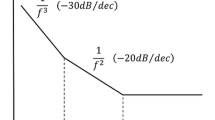Abstract
A Class-C voltage-control-oscillator (VCO) IC with an amplitude feedback loop for ultra-low-voltage application is proposed. The Class-C VCO consists of an LC-VCO circuit and an amplitude feedback loop to shift LC-VCO bias condition from initial Class-AB start-up to steady Class-C low current oscillation. The amplitude feedback loop is formed by a detector and a comparator with low voltage supply. The LC-VCO IC has been designed, fabricated and fully evaluated using 65-nm CMOS technology. The fabricated Class-C VCO IC exhibits a measured phase noise of \(-\)111 dBc/Hz at 1 MHz offset from the 2.43 GHz carrier frequency at a supply voltage of only 0.3 V.

















Similar content being viewed by others
References
Kwok, K., & Luong, H. C. (2005). Ultra-low-voltage high-performance CMOS VCOs using transformer feedback. IEEE Journal of Solid-State Circuits, 40, 652–660.
Li, G., Liu, L., Tang, Y., & Afshari, E. (2012). A low-phase-noise wide-tuning range oscillator based on resonant mode switching. IEEE Journal of Solid-State Circuits, 47, 1295–1308.
Kurachi, S., Yoshimasu, T., Liu, H., Itoh, N., & Yonemura, K. (2007). A SiGe BiCMOS VCO IC with highly linear Kvco for 5-GHz-band wireless LANs. IEICE Transactions on Electronics, E90–C, 1228–1233.
Liu, Q., Takigawa, Y., Kurachi, S., Itoh, N., & Yoshimasu, T. (2011). A 1.2–3.2 GHz CMOS VCO IC utilizing transformer-based variable inductors and AMOS varactors. IEICE Transactions on Electronics, E94–A, 568–573.
Mazzanti, A., & Andreani, P. (2013). A push-pull class-C CMOS VCO. IEEE Journal of Solid-State Circuits, 48, 724–732.
Mazzanti, A., & Andreani, P. (2008). Class-C harmonic CMOS VCOs, with a general result on phase noise. IEEE Journal of Solid-State Circuits, 43, 2716–2729.
Fanori, L., & Andreani, P. (2012). Low-phase-noise 3.4–4.5 GHz dynamic-bias class-C CMOS VCOs with a FoM of 191 dBc/Hz. In Proceedings of European Solid-State Circuits Conference (ESSCIRC) (pp. 406–409).
Chen, J., Jonsson, F., Carlsson, M., Hedenas, C., & Zheng, L.-R. (2011). A low power, startup ensured and constant amplitude class-C VCO in 0.18 μm CMOS. IEEE Microwave and Wireless Components Letters, 21, 427–429.
Deng, W., Okada, K., & Matsuzawa, A. (2013). Class-C VCO with amplitude feedback loop for robust start-up and enhanced oscillation swing. IEEE Journal of Solid-State Circuits, 48, 429–440.
Yang, X., Uchida, Y., Xu, K., Wang, W., & Yoshimasu, T. (2013). 2.4 GHz-band ultra-low-voltage class-C LC-VCO IC in 65 nm CMOS technology. In Proceedings of Asia-Pacific Microwave Conference (APMC), 5–8 Nov. 2013, (pp. 325–327).
Arora, N. (2007). Mosfet modeling for VLSI simulation: Theory and practice. Singapore: World Scientific.
Yang, X., Uchida, Y., Liu, Q., & Yoshimasu, T. (2012). Low-power ultra-wideband power detector IC in 130 nm CMOS technology. IEEE MTT-S International Microwave Workshop Series on Millimeter Wave Wireless Technology and Applications (IMWS), 18–20 Sept. 2012, (p. 4).
Ikeda, S., Kamimura, T., Lee, S., Kanemaru, N., Ito, H., Ishihara, N., Masu, & K. (2012). A 0.5-V 5.5-GHz class-C-VCO-based PLL with ultra-low-power ILFD in 65 nm CMOS. IEEE Asian Solid-State Circuits Conference (ASSCC), 12–14 Nov. 2012 (pp. 357–360).
Okada, K., Nomiyama, Y., Murakami, R., & Matsuzawa, A. (2009). A 0.114-mW dual-conduction class-C CMOS VCO with 0.2-V power supply. Symposium on VLSI Circuits, 16–18 Jun. 2009 (pp. 228–229).
Liu, P., Sah, S. P., Jung, J., Upadhyaya, P., Nguyen, T. N., & Heo, D. (2013). Design techniques for load-independent direct bulk-coupled low power QVCO. IEEE Transactions on Microwave Theory and Techniques, 61, 3658–3665.
Siriburanon, T., Deng, W., Okada, K., & Matsuzawa, A. (2013). A constant-current-controlled class-C VCO using a self-adjusting replica biasing scheme. In Proceedings of the European Microwave Integrated Circuits Conference (ESSCIRC), 6–8 Oct. 2013 (pp. 109–112).
Tohidian, M., Fotowat-Ahmadi, A., Kamarei, M., & Ndagijimana, F. (2011). High-swing class-C VCO. In Proceedings of European Solid-State Circuits Conference (ESSCIRC) (pp. 495–498).
Leeson, D. B. (1966). A simple model of feedback oscillator noise spectrum. IEEE Proceedings Letters, 54, 329–330.
Acknowledgments
This work is supported by Japan Society for the Promotion of Science (JSPS) KAKENHI Grant-in-Aid for Scientific Research Number 23360162. This work is supported by VDEC, University of Tokyo in collaboration with Cadence Design Systems Inc, Mentor Graphics Inc, and Agilent Technologies Japan Ltd.
Author information
Authors and Affiliations
Corresponding author
Rights and permissions
About this article
Cite this article
Yang, X., Uchida, Y., Xu, K. et al. A 0.3-V power supply 2.4-GHz-band Class-C VCO IC with amplitude feedback loop in 65-nm CMOS. Analog Integr Circ Sig Process 81, 583–591 (2014). https://doi.org/10.1007/s10470-014-0351-8
Received:
Revised:
Accepted:
Published:
Issue Date:
DOI: https://doi.org/10.1007/s10470-014-0351-8




